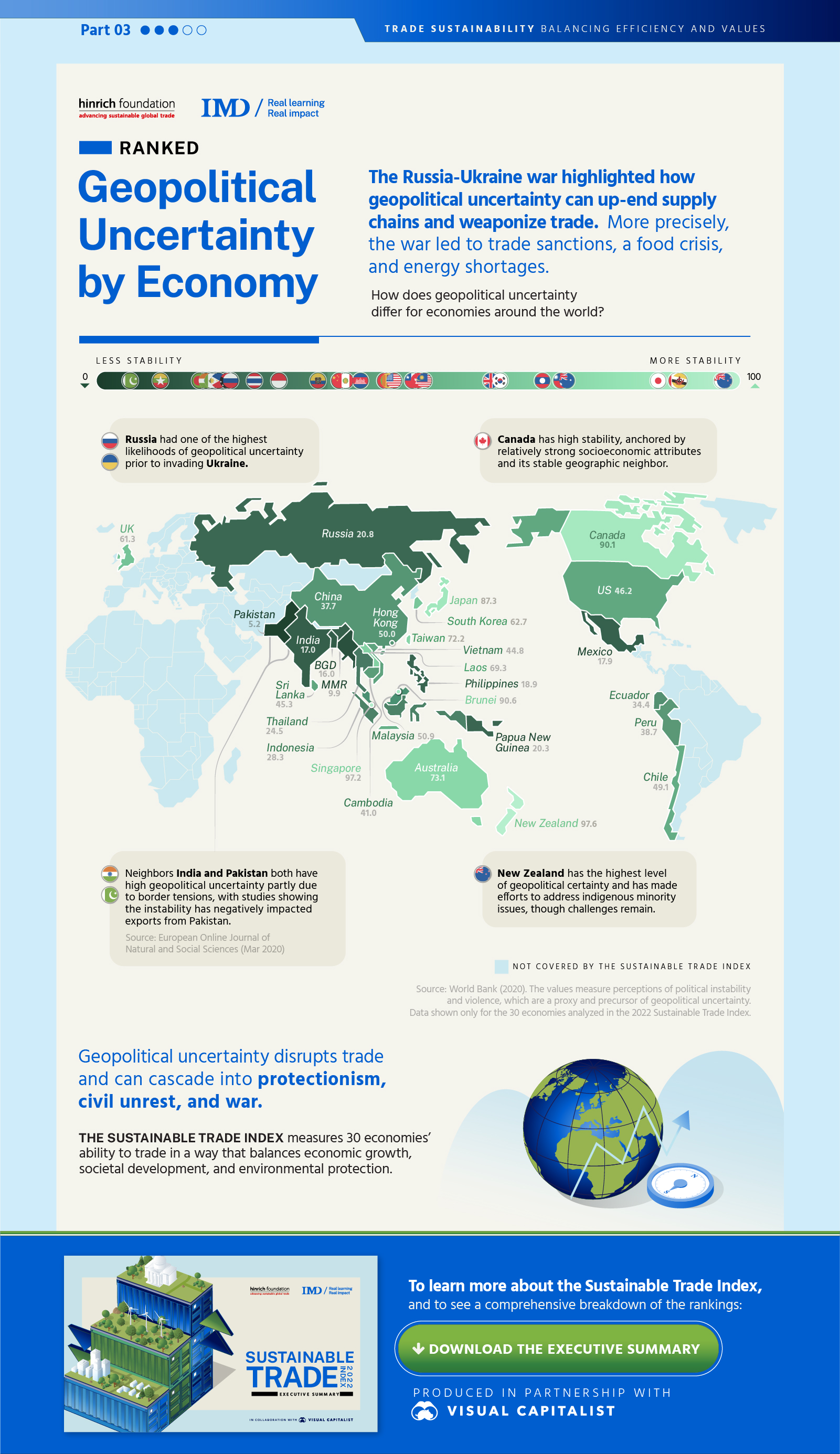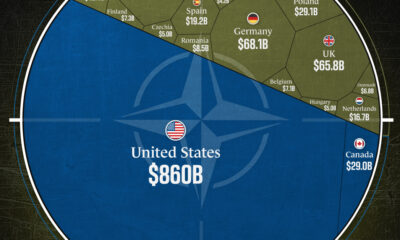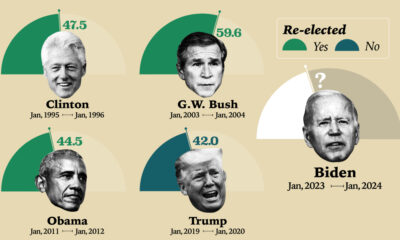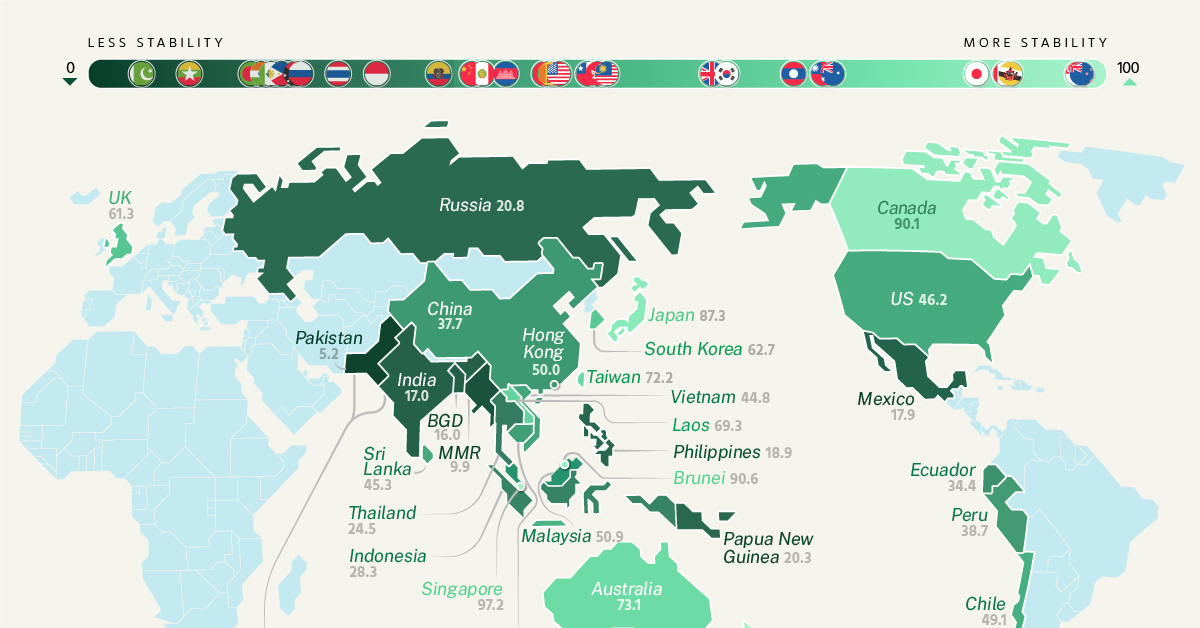Mapped: Geopolitical Risk by Economy

Geopolitical Risk by Economy
The Russia-Ukraine war highlighted how geopolitical risk can up-end supply chains and weaponize trade. More precisely, the war led to trade sanctions, a food crisis, and energy shortages.
This graphic from The Hinrich Foundation, the third in a five-part series on the sustainability of trade, explores how geopolitical risk differs by economy. It pulls data from the 2022 Sustainable Trade Index, which The Hinrich Foundation produced in collaboration with the IMD World Competitiveness Center.
Breaking Down Geopolitical Risk
Geopolitical risk has a strong correlation with GDP per capita, meaning that developing economies typically have less stability.
The following table shows how geopolitical risk breaks down for select economies that are covered in the 2022 Sustainable Trade Index. A lower number indicates less stability, while a higher number indicates more stability.
| Economy | Geopolitical Stability |
|---|---|
| Pakistan | 5.2 |
| Myanmar | 9.9 |
| Bangladesh | 16.0 |
| India | 17.0 |
| Mexico | 17.9 |
| Philippines | 18.9 |
| Papua New Guinea | 20.3 |
| Russia | 20.8 |
| Thailand | 24.5 |
| Indonesia | 28.3 |
| Ecuador | 34.4 |
| China | 37.7 |
| Peru | 38.7 |
| Cambodia | 41.0 |
| Vietnam | 44.8 |
| Sri Lanka | 45.3 |
| U.S. | 46.2 |
| Chile | 49.1 |
| Hong Kong | 50.0 |
| Malaysia | 50.9 |
| UK | 61.3 |
| South Korea | 62.7 |
| Laos | 69.3 |
| Taiwan | 72.2 |
| Australia | 73.1 |
| Japan | 87.3 |
| Canada | 90.1 |
| Brunei | 90.6 |
| Singapore | 97.2 |
| New Zealand | 97.6 |
Source: World Bank, based on the latest available data from 2020. Values measure perceptions of political instability and violence, which are a proxy and precursor to geopolitical risk.
New Zealand has the highest level of stability, likely supported by the fact that it is a small nation with no direct neighbors. The country has taken steps to repair relationships with Indigenous peoples, through land and monetary settlements, though challenges remain.
The U.S. has moderate stability. It has been impacted by increasing political polarization that has led to people having lower trust in institutions and more negative views of people from the opposing party. As the world’s largest economy, the U.S. also faces geopolitical risk such as escalating tariffs in the U.S.-China trade war.
Want more insights into trade sustainability?
Download the 2022 Sustainable Trade Index for free.
Russia has one of the lowest levels of stability. The country’s invasion of Ukraine has led to war along with economic roadblocks that restrict normal trade activity. For instance, sanctions against Russia and blocked Ukrainian ports led to a food shortage. The two countries supply a third of the world’s wheat and 75% of the sunflower oil supply.
The Impact of Geopolitical Uncertainty on Trade
Geopolitical risk can lead to civil unrest and war. It also has economic consequences including trade disruptions. As a result of the Russia-Ukraine war, the World Bank estimates that “world trade will drop by 1%, lowering global GDP by 0.7% and GDP of low-income economies by 1%.” A separate study found that Pakistan’s history of political instability has negatively affected trade in the country.
Of course, geopolitical risk is just one component of an economy’s trade sustainability. The Sustainable Trade Index uses a number of other metrics to measure economies’ ability to trade in a way that balances economic growth, societal development, and environmental protection. To learn more, visit the STI landing page where you can download the report for free.
The fourth piece in this series will explore air pollution by economy, and how it is influenced by economic activity such as trade.

-

 War1 month ago
War1 month agoVisualized: Top 15 Global Tank Fleets
Heavily armed and armored, the modern tank is a versatile and mobile weapons platform, and a critical piece of contemporary warfare.
-

 Politics2 months ago
Politics2 months agoMapped: 2024 Global Elections by Country
It’s election year around the world, and this map of 2024 global elections by country shows just how many people will be impacted.
-

 Politics2 months ago
Politics2 months agoWhich Countries Meet NATO’s Spending Target?
In 2023, only 11 member countries reached NATO’s target of spending 2% of their country’s GDP on defense.
-

 Politics2 months ago
Politics2 months agoBreaking Down $1.3T in NATO Defense Spending
The U.S. accounts for 68% of NATO’s total combined defense spending.
-

 Politics2 months ago
Politics2 months agoHow Do Democrats and Republicans Feel About Certain U.S. Industries?
A survey looked at U.S. industry favorability across political lines, showing where Democrats and Republicans are divided over the economy.
-

 Politics3 months ago
Politics3 months agoU.S. President Approval Ratings in Their Third Year (1955-2023)
How does Biden’s approval rating stack up against other presidents? This graphic compares presidents across modern history.








